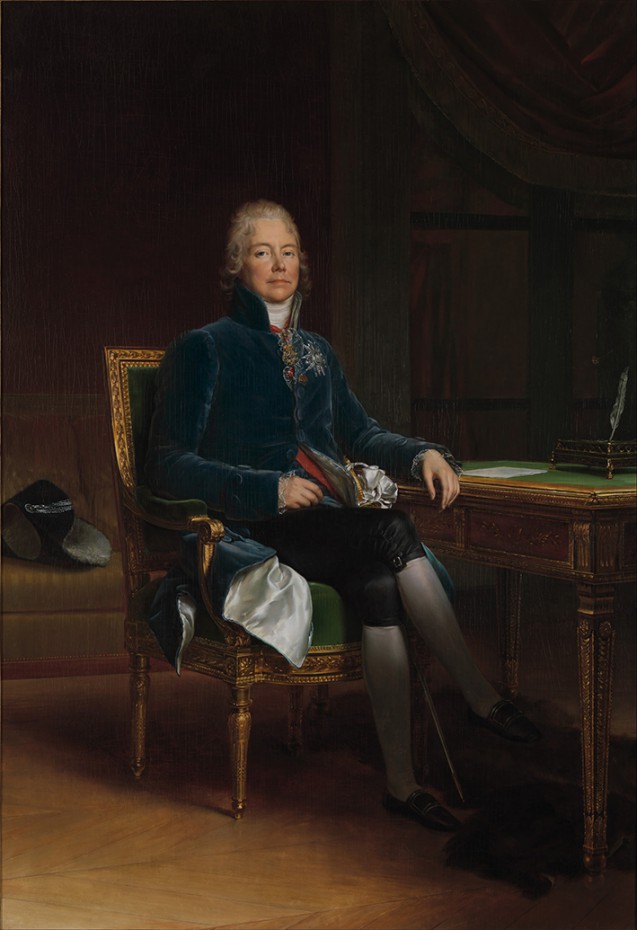This portrait of Charles Maurice de Talleyrand-Perigord (1754-1838), Prince of Benevento, reflects the reputation of its subject: fearless and serene, with a slight smile (even a smirk?) on his lips. When Gérard painted it during the year 1807-1808, Talleyrand had resigned as Napoleon’s foreign minister on the 10 August, 1807 because of his opposition to the Emperor’s plans for an alliance with Russia. This did not, however, prevent him from receiving, on 14 August 1807, the title of “vice-grand-électeur de l’Empire”, nor indeed from accompanying Napoleon as an advisor in September 1808 to the negotiations of this alliance in Erfurt (cf. Nicolas Gosse’s painting of that meeting). On this occasion he manipulated both the Russian and French emperors in order to sabotage the agreement. An alliance (of principle) was nevertheless concluded, on October 14, 1808, the same day that this painting was exhibited for the first time at the Salon of 1808.
Commissioned by Talleyrand for his private collection, it had been “planned” that this painting would be presented at the Salon as a symbol of the Prince of Benevento’s resounding success at Erfurt. Unlike the 1807 portrait by Prud’hon, in which he posed dressed as Grand Chamberlain (at the Musée Carnavalet), Talleyrand is represented here in relatively informal and simple dress rendering more visible the insignia of the Legion d’honneur, of which he wears the “Grand Cordon” awarded to him by Napoleon in 1805. The painting shows Talleyrand in a private and comfortable interior decorated in the Louis XVI style (a not accidental detail given the painting’s context in the heyday of the Empire style). The chair, dating from the 1770s, was probably made by Georges Jacob (1739-1814), founder of a dynasty of carpenters and cabinetmakers which dominated the first half of the nineteenth century. Talleyrand’s posture is serious but relaxed: the “vice-grand-élector” is at work – the presence of the office paper and ink attest to this – and he turns towards the viewer, crossing his legs nonchalantly.
Nothing in this portrait speaks of the huge upset that would befall the sitter just a few months after the Salon of 1808. On leaving Erfurt, Napoleon headed for Spain to put down the insurrection facing his brother Joseph there. Talleyrand tried to take advantage of the Emperor’s absence to get Fouché, usually an enemy but here a temporary ally, to join him in a plot to find an heir for the imperial throne, given Napoleon’s lack of descendants. And they also tried to get Joachim Murat on board. When Napoleon learned of the conspiracy, he straight away returned to Paris, arriving on 23 January 1809, and removed his Grand Chambellan from office (though he spared his partner in crime, the Police Minister) four days later. Indeed, he was still badmouthing the ex-chambellan the following day, during a council meeting. Talleyrand did not lose everything. He was allowed to keep his post as Vice-Grand-Électeur de l’Empire, showing thereby that Napoleon had decided that he still needed Charles-Maurice on board; at least for the moment. That being said, the ex-bishop of Autun was getting ever closer to the Austrian Empire at this time. The half-smile in this portrait is emblematic of what Talleyrand was, namely, an imperturbable career politician, always somehow able to keep himself afloat.
Whilst the presentation at the Salon was of benefit to the reputation of its subject, the work itself was not to remain frozen in time. Indeed, the subsequent history of the work tells us much about the political personality of its sponsor and his relationship to power. We know that some time later, around 1814-1815, at the time of the fall of the Empire (in which the Prince of Benevento participated with gusto), Talleyrand asked Gerard to add other details that showed his “career change”, namely: the emblem of the Order of the Golden Fleece, suspended from a ribbon, which Ferdinand of Spain awarded to Talleyrand at the Congress of Vienna; and also some changes to the Legion d’Honneur medal, modifications which had been introduced by Louis XVIII, then on the throne, thereby highlighting his new allegiance.
The portrait remained in the Talleyrand family through the nephew of the Prince of Benevento until 2012 when it was sold, through the dealer Wildenstein, to the Metropolitan Museum of Art in New York. A print after this painting is in the collection at Versailles, Paris.
For more information see Talleyrand, le Prince Immobile, (in French) by Emmanuel de Waresquiel, in which the author evokes the reaction of Goethe upon seeing a reproduction of this picture, as well as the relationship between Talleyrand and Gérard. Indeed as a friend of the future bride of the prince, of whom he also made a well-known portrait in 1803, the painter owed him the continuity of his career under the Restoration.
Marie de Bruchard (May 2015, updated January 2019) trans R.Y. and P.H.


